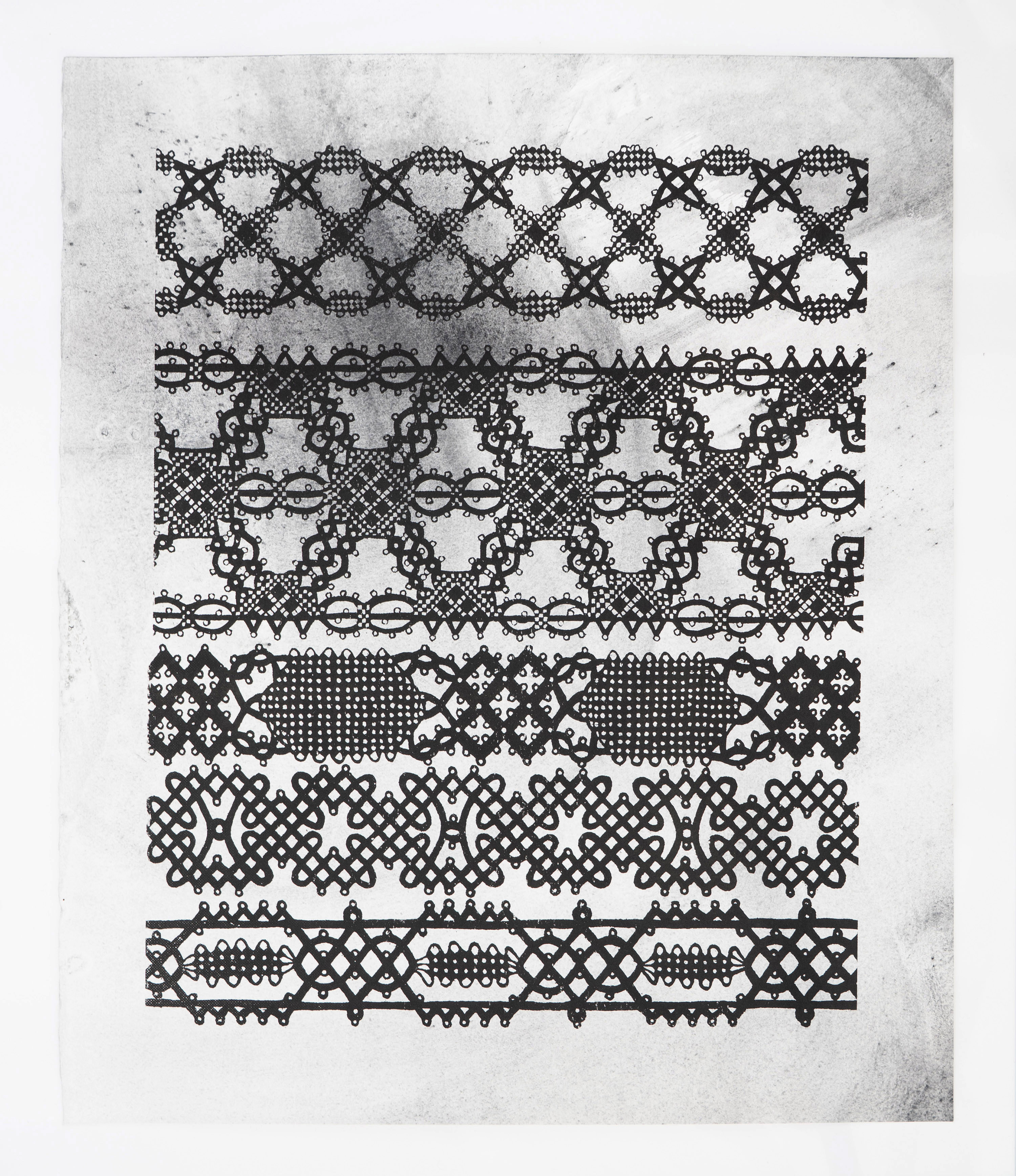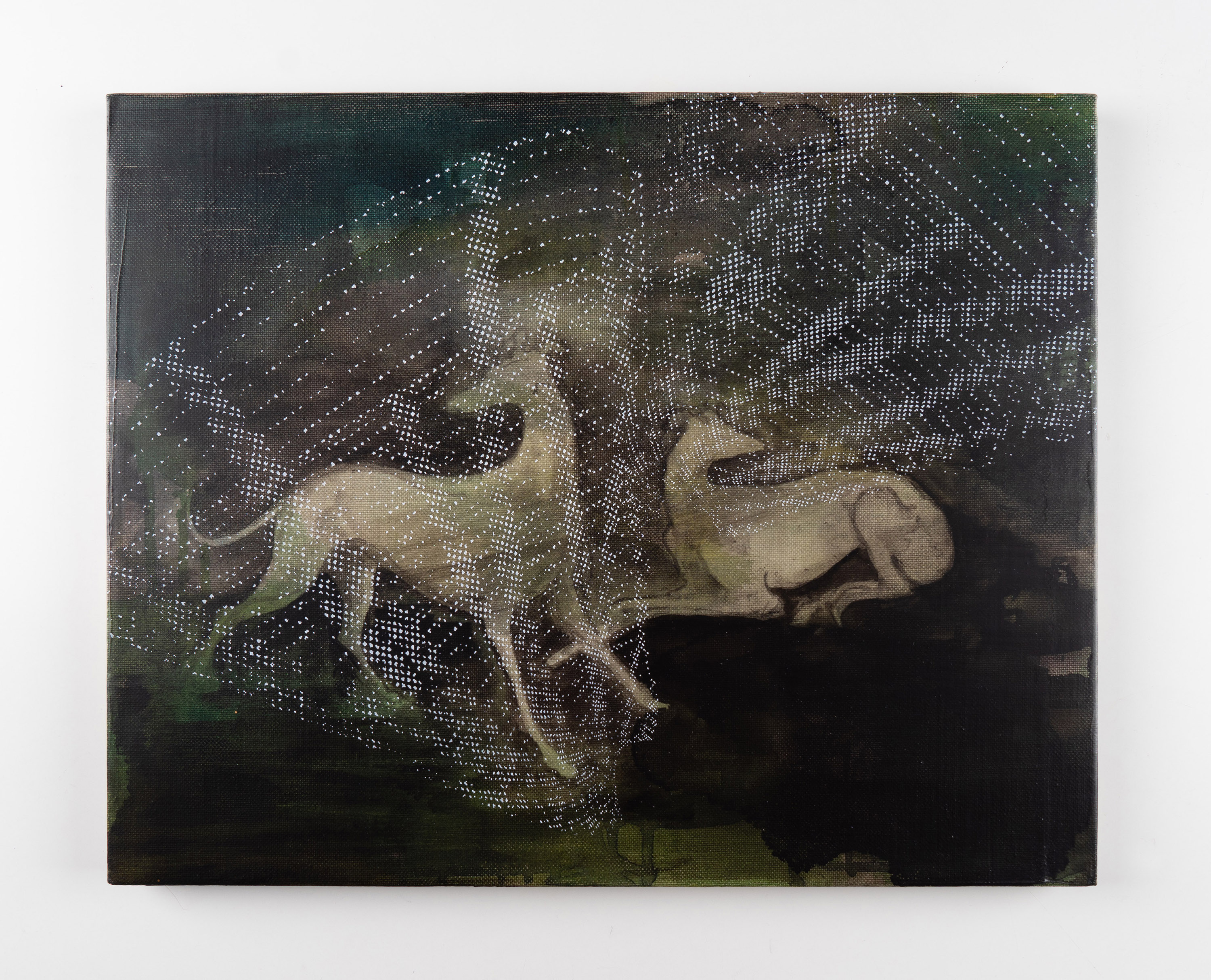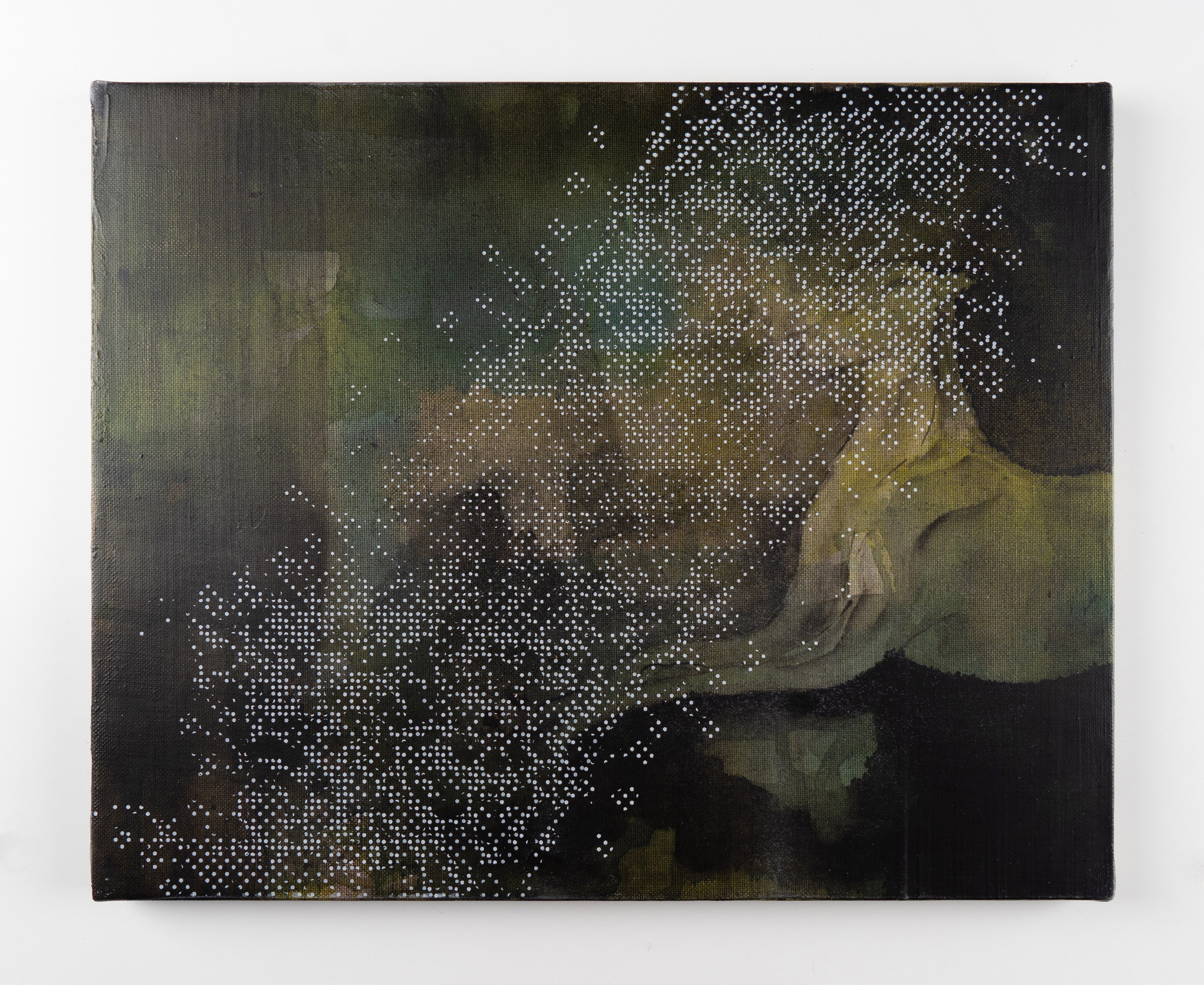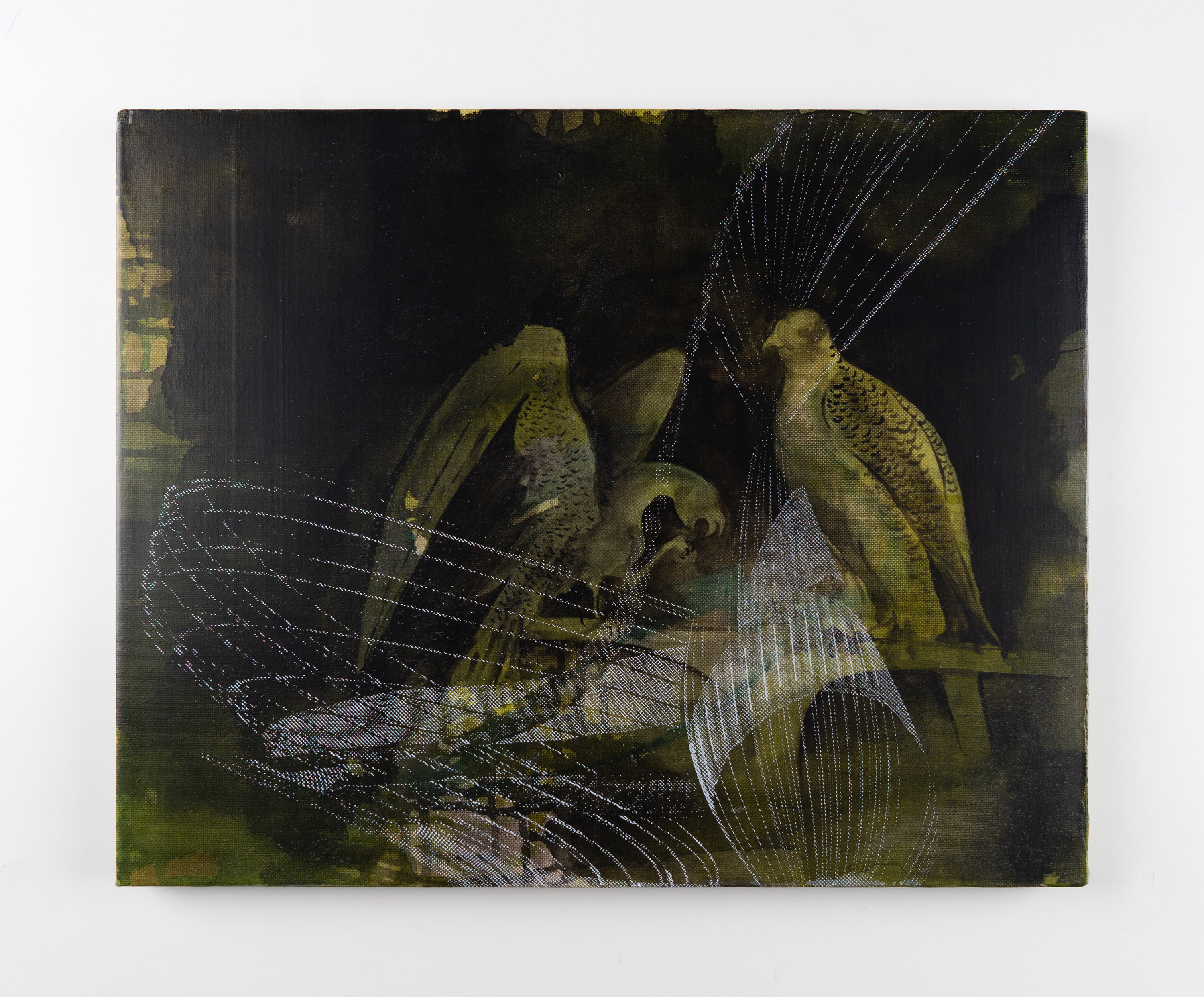Katja Davar
Lace it was
18. Juni – 3. September 2023
nach Vereinbarung
mail@provinzeditionen.de
@provinzeditionen
scroll for english version

In der Arbeit von Katja Davar (geboren 1968 in London, lebt in Köln) treffen natur- und kulturwissenschaftliche Diskurse aufeinander. Die Künstlerin verdichtet die heterogenen Inhalte zu komplexen Bildwelten. Bereits der Ausstellungstitel „Lace it was“ macht darauf aufmerksam, dass die gezeigten Tierdarstellungen über sich hinausweisen. Sie sind Gemälden und Bilderzyklen aus verschiedenen Epochen und Kulturkreisen entlehnt. Beispielweise stammen sie aus Persien, von „Shahnameh“, dem „Buch der Könige“ geschrieben um 1000 u. Z. und von Habiballah von Savas Illustration, datiert um 1600, zu der älteren überlieferten Dichtung Mantiq al-tair („Sprache der Vögel“). Eine weitere Quelle sind Gemälde des englischen Tiermalers und Kupferstechers George Stubbs.
Ein wesentliches Stilelement von Katja Davar ist die Überlagerung von grafischen und zeichnerischen Ebenen, die formal und inhaltlich den Raum für weiterführende Assoziationen schaffen. Sind es oftmals konstruktiv-geometrische Strukturen, handelt es sich hier um historische Muster von Spitze, die mit weißer Farbe über die mit Lack und Tusche ausgeführte Zeichnung gesiebdruckt wurden. Dabei dienten alte Musterbücher, die das Handwerk als Anleitung für die Herstellung von Spitzen nutzten, und Bilder der europäischen Potraitmalerei des 17. Jahrhunderts als Vorlagen. Die älteste schriftliche Aufzeichnung dieser variantenreichen und diffizilen Technik – es wird unterschieden u. a. zwischen Nadel- oder Klöppelspitze – ist das Musterbuch „Le Pompe“, das 1557 in Venedig veröffentlicht wurde. Die Spitze erzählt viel über die Umstände in jener Zeit. Sie herzustellen, war viele Jahrhunderte die Handarbeit schlechthin. Sie erforderte Zeit, Geduld und Geschick. Entsprechend teuer wurde sie gehandelt und war unerschwinglich für alle Stände unterhalb des Adels. Wer damals also seinen Reichtum und die damit verbundene Macht zeigen wollte, der tat dies mit Schmuck, mit Edelsteinen und -metallen und eben mit Spitze.
Ein wesentliches Stilelement von Katja Davar ist die Überlagerung von grafischen und zeichnerischen Ebenen, die formal und inhaltlich den Raum für weiterführende Assoziationen schaffen. Sind es oftmals konstruktiv-geometrische Strukturen, handelt es sich hier um historische Muster von Spitze, die mit weißer Farbe über die mit Lack und Tusche ausgeführte Zeichnung gesiebdruckt wurden. Dabei dienten alte Musterbücher, die das Handwerk als Anleitung für die Herstellung von Spitzen nutzten, und Bilder der europäischen Potraitmalerei des 17. Jahrhunderts als Vorlagen. Die älteste schriftliche Aufzeichnung dieser variantenreichen und diffizilen Technik – es wird unterschieden u. a. zwischen Nadel- oder Klöppelspitze – ist das Musterbuch „Le Pompe“, das 1557 in Venedig veröffentlicht wurde. Die Spitze erzählt viel über die Umstände in jener Zeit. Sie herzustellen, war viele Jahrhunderte die Handarbeit schlechthin. Sie erforderte Zeit, Geduld und Geschick. Entsprechend teuer wurde sie gehandelt und war unerschwinglich für alle Stände unterhalb des Adels. Wer damals also seinen Reichtum und die damit verbundene Macht zeigen wollte, der tat dies mit Schmuck, mit Edelsteinen und -metallen und eben mit Spitze.
Katja Davars Bilderzyklus und die großflächige Wandzeichnung der filigranen Spitzenmuster verweisen auf diese vielschichtigen Deutungsebenen. Miteinander verwoben werden verschiedene Techniken und Darstellungen unterschiedlichen zeitlichen und kulturellen Ursprungs. Der Blick, der uns durch Spitze und auf Spitze gewährt wird, läßt uns gleichermaßen teilhaben an ehemals „paradiesischen“ oder ursprünglichen Zuständen und an deren Verlust. Dieser kann ins 15. Jahrhundert verortet werden und setzt ein mit der sogenannten „Entdeckung der Welt“, die verbunden ist mit der beginnenden rücksichtslosen Kolonialisierung durch die Europäer. Trotz ihrer Schönheit offenbaren Davars Werke historische Strukturen und Machtverhältnisse und deren koloniale Kontinuität, die sich bis in unsere heutige Zeit fortsetzt.
Katja Davar lehrt als Professorin für experimentelles Zeichnen an der Hochschule Mainz. Ihr Studium absolvierte Katja Davar am Central Saint Martins College of Art and Design in London, der Kunstakademie Düsseldorf und an der Kunsthochschule für Medien in Köln. Ihre Arbeiten wurden in zahlreichen Einzel- und Gruppenausstellungen im In- und Ausland gezeigt, z.B. 2020 - 2021 Notes from a Flickering Stage, Kunstverein Heilbronn (DE), 2020 These rooms of Earth and Stones, (with Michel Bouanger) Galerie de l‘UQAM, Montreal (CA), 2019 Electric Spinning Gaze, Skulpturenmuseum Glaskasten Marl (DE), 2022 Ornamental Forest Geology, Kunstmuseum Gelsenkirchen (DE).
Katja Davar lehrt als Professorin für experimentelles Zeichnen an der Hochschule Mainz. Ihr Studium absolvierte Katja Davar am Central Saint Martins College of Art and Design in London, der Kunstakademie Düsseldorf und an der Kunsthochschule für Medien in Köln. Ihre Arbeiten wurden in zahlreichen Einzel- und Gruppenausstellungen im In- und Ausland gezeigt, z.B. 2020 - 2021 Notes from a Flickering Stage, Kunstverein Heilbronn (DE), 2020 These rooms of Earth and Stones, (with Michel Bouanger) Galerie de l‘UQAM, Montreal (CA), 2019 Electric Spinning Gaze, Skulpturenmuseum Glaskasten Marl (DE), 2022 Ornamental Forest Geology, Kunstmuseum Gelsenkirchen (DE).
Verfügbare Werke:
Katja Davar
If it wasn’t for the Daughters - Ell, 2023
Zwölf Unikate, Tusche, Lack, Firnis auf Leinwand, aufgezogen auf Holz, in grauer Schattenfuge, 40 x 50 cm
je 3.600 €
Anfrage
Katja Davar
Codes to Crack, 2023
Siebdruck, Tusche, Acryl und Firnis auf
Bockingford Water Colour Papier 400 g
Auflage: 8 (3 E.A.)
60,6 x 51,5 cm
je 550 €
Anfrage








Katja Davar
Footnotes in the Dark, 2023
Neun Unikate, Tusche und Interferenz-Acrylfarbe auf Karton 350 g, 22,7 x 17,3 cm
je 750 €
Anfrage
Katja Davar
Show Me the Code, 2023
Wandbild, Grafit und Firnis
280 x 570 cm (Maße variabel)
auf Anfrage







Provinz
Katja Davar: Lace it was
June 18 – September 3, 2023
by appointment
mail@provinzeditionen.de
@provinzeditionen
Katja Davar: Lace it was
June 18 – September 3, 2023
by appointment
mail@provinzeditionen.de
@provinzeditionen
In the works of Katja Davar (born in London in 1968, lives in Cologne), multiple discourses from the worlds of natural and cultural sciences meet. The artist condenses heterogeneous content into complex visual worlds. The title of the exhibition alone – Lace it was – suggests that the images of animals shown here transcend themselves. The animals shown in landscape settings are transcribed from paintings and image cycles from varying epochs and cultures. Shahnameh, the Book of Kings, written around 1000 CE is one important source as is Habbiballah of Sava’s illustrated manuscript, of the traditional poem Mantiq al-tair Language of the Birds. Another source are several works of the British artist George Stubbs.
A key stylistic element in the work of Katja Davar is her layering of graphics and drawings, creating formal and contextual space for further associations. In this case, the constructive-geometric structures are authentic lace patterns, which have been screen printed in white over the drawings which are executed in ink and varnish. These structures are based on ancient pattern books which were used to provide instructions to the lace-makers, as well as using individual lace depictions from European portraiture of the 17th century. The oldest written record of this varied and difficult technique - a distinction is made between needle lace and bobbin lace, among others - is the pattern book „Le Pompe“, published in Venice in 1557. Lace tells us much about the socio-political context and conditions of Europe from the 16th century onwards. For centuries, lace making was the epitome of needlework, requiring time, patience and skill.
A key stylistic element in the work of Katja Davar is her layering of graphics and drawings, creating formal and contextual space for further associations. In this case, the constructive-geometric structures are authentic lace patterns, which have been screen printed in white over the drawings which are executed in ink and varnish. These structures are based on ancient pattern books which were used to provide instructions to the lace-makers, as well as using individual lace depictions from European portraiture of the 17th century. The oldest written record of this varied and difficult technique - a distinction is made between needle lace and bobbin lace, among others - is the pattern book „Le Pompe“, published in Venice in 1557. Lace tells us much about the socio-political context and conditions of Europe from the 16th century onwards. For centuries, lace making was the epitome of needlework, requiring time, patience and skill.
It was sold at accordingly high prices and was unaffordable for any class below the nobility. Anyone who wanted to demonstrate their wealth and associated power did it through jewels, precious stones and metals – and lace. Katja Davar’s series of works and her large format mural of intricate lace patterns point to these complex levels of interpretation. Her work weaves together different techniques and depictions that were created at different times and in different cultures. As we look at and through the lace, we are allowed to participate in former “paradisical” or unspoilt conditions, and the loss thereof. The latter can be put into the context of the 15th century, beginning with the “discovery of the world”, which is connected to the beginnings of the ruthless European colonisation. Despite their beauty, Davar’s works reveal historical structures and the distribution of power as well as the colonial continuity of both still present to this very day.
Katja Davar teaches as Professor for Experimental Drawing at University of Applied Sciences, Mainz. Studies at Central Saint Martins College of Art and Design in London, Kunstakademie Düsseldorf and Kunsthochschule für Medien, Cologne. International Exhibitions include 2020 - 2021 Notes from a Flickering Stage, Kunstverein Heilbronn (DE), 2020 These rooms of Earth and Stones, (with Michel Bouanger) Galerie de l‘UQAM, Montreal (CA), 2019 Electric Spinning Gaze, Skulpturenmuseum Glaskasten Marl (DE), 2022 Ornamental Forest Geology, Kunstmuseum Gelsenkirchen (DE).
Katja Davar teaches as Professor for Experimental Drawing at University of Applied Sciences, Mainz. Studies at Central Saint Martins College of Art and Design in London, Kunstakademie Düsseldorf and Kunsthochschule für Medien, Cologne. International Exhibitions include 2020 - 2021 Notes from a Flickering Stage, Kunstverein Heilbronn (DE), 2020 These rooms of Earth and Stones, (with Michel Bouanger) Galerie de l‘UQAM, Montreal (CA), 2019 Electric Spinning Gaze, Skulpturenmuseum Glaskasten Marl (DE), 2022 Ornamental Forest Geology, Kunstmuseum Gelsenkirchen (DE).
more / mehr von Katja Davar:





















